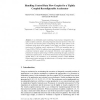Free Online Productivity Tools
i2Speak
i2Symbol
i2OCR
iTex2Img
iWeb2Print
iWeb2Shot
i2Type
iPdf2Split
iPdf2Merge
i2Bopomofo
i2Arabic
i2Style
i2Image
i2PDF
iLatex2Rtf
Sci2ools
ICESS
2007
Springer
2007
Springer
Handling Control Data Flow Graphs for a Tightly Coupled Reconfigurable Accelerator
In an embedded system including a base processor integrated with a tightly coupled accelerator, extracting frequently executed portions of the code (hot portion) and executing their corresponding data flow graph (DFG) on the accelerator brings about more speedup. In this paper, we intend to present our motivations for handling control instructions in DFGs and extending them to Control DFGs (CDFGs). In addition, basic requirements for an accelerator with conditional execution support are proposed. Moreover, some algorithms are presented for temporal partitioning of CDFGs considering the target accelerator architectural specifications. To show the effectiveness of the proposed ideas, we applied them to the accelerator of an extensible processor called AMBER. Experimental results represent the effectiveness of covering control instructions and using CDFGs versus DFGs.
Accelerator Architectural Specifications | Control Instructions | Corresponding Data Flow | ICESS 2007 | Software Engineering |
| Added | 08 Jun 2010 |
| Updated | 08 Jun 2010 |
| Type | Conference |
| Year | 2007 |
| Where | ICESS |
| Authors | Hamid Noori, Farhad Mehdipour, Morteza Saheb Zamani, Koji Inoue, Kazuaki Murakami |
Comments (0)

